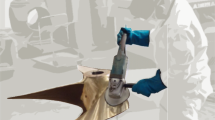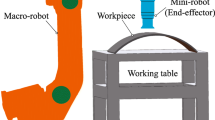Abstract
Nowadays, a laboratory operator in the areas of chemistry, biology or medicine spends considerable time performing micropipetting procedures, a common, monotonous and repetitive task which compromises the ergonomics of individuals, namely related to wrist musculoskeletal disorders. In this work, the design of a kinesthetic teaching approach for automating the micropipetting technique is presented, allowing to redirect the operator to other non-repetitive tasks, aiming to reduce the exposure to ergonomic risks. The proposed robotic solution has an innovative gripping system capable of supporting, actuating and regulating the volume of a manual micropipette. The system is able to configure the position of diverse laboratory materials, such as lab containers and plates, on the workbench through a collaborative robotic arm, providing flexibility to adapt to different procedures. A projected human-machine interface, which combines the display of information on the workbench with an infrared based interaction device was developed, providing a more intuitive interaction between the operator and the system during the configuration and operation phases. In contrast to the majority of the existing liquid handling systems, the proposed system allows the operator to place the materials freely on the workbench and the usage of different materials’ variants, facilitating the implementation of the system in any laboratory. The attained performance and ease of use of the system were very encouraging since all the defined tasks in the conducted experiments were successfully performed by users with minimum training, highlighting its potential inclusion in the laboratory routine panorama.












Similar content being viewed by others
Availability of data and material
Not applicable
Code availability
Not applicable
References
Gan SD, Patel KR (2013) Enzyme immunoassay and enzyme-linked immunosorbent assay. J Investig Dermatol 133(9):1–3. https://doi.org/10.1038/jid.2013.287
Klingenberg M (2005) When a common problem meets an ingenious mind: the invention of the modern micropipette. EMBO Reports 6(9):797–800. https://doi.org/10.1038/sj.embor.7400520
Kong F, Yuan L, Zheng YF, Chen W (2012) Automatic liquid handling for life science: a critical review of the current state of the art. Journal of Laboratory Automation 17(3):169–185. https://doi.org/10.1177/2211068211435302
Tudor P (2011) Standing the test of time - laboratory news. https://www.labnews.co.uk/article/2027980/standing_the_test_of_time, Accessed 18 March 2021
Muggleton JM, Allen R, Chappell PH (1999) Hand and arm injuries associated with repetitive manual work in industry: a review of disorders, risk factors and preventive measures. Ergonomics 42(5):714–739. https://doi.org/10.1080/001401399185405
Barr AE, Barbe MF, Clark BD (2004) Work-related musculoskeletal disorders of the hand and wrist: Epidemiology, pathophysiology, and sensorimotor changes. Journal of Orthopaedic & Sports Physical Therapy 34(10):610–627. https://doi.org/10.2519/jospt.2004.34.10.610
Wu JZ, Sinsel EW, Shroyer JF, Welcome DE, Zhao KD, An KN, Buczek FL (2013) The musculoskeletal loading profile of the thumb during pipetting based on tendon displacement. Med Eng Phys 35(12):1801–1810. https://doi.org/10.1016/j.medengphy.2013.08.004
Kim E, Aqlan F, Freivalds A (2019) Effect of pipette design on musculoskeletal loading on hand. In: 2019 Institute of industrial and systems engineers annual conference and expo, IISE 2019, Institute of Industrial and Systems Engineers, IISE, pp 13–18
Lab Autopedia (2009) The history of automated liquid handling. http://diyhpl.us/bryan/irc/labautopedia-history-of-automated-liquid-handling.html, Accessed 18 March 2021
Buie J (2009) Evolution of the pipette. https://www.labmanager.com/lab-product/evolution-of-the-pipette-20163, Accessed 18 March 2021
Hamilton®; (2016) Hamilton microlab star — small liquid handler. https://www.hamiltoncompany.com/automated-liquid-handling/platforms/microlab-star, Accessed 5 April 2021
Evisa (2021) Lissy®; liquid sampling system (zinsser analytic gmbh ) — evisa’s instruments database. http://www.speciation.net/Database/Instruments/Zinsser-Analytic-GmbH/LISSY-Liquid-Sampling-System-;i806, Accessed 5 April 2021
Zinsser (2016a) Lissy®; flexible pipetting robot. http://www.zinsserna.com/files/Zinsser_Lissy.pdf, Accessed 5 April 2021
Zinsser (2016b) Lissy®;. http://www.zinsserna.com/lissy.htm, Accessed 5 April 2021
HudsonRobotics (2020) Solo liquid handler. https://hudsonrobotics.com/products/liquid-handling/solo-liquid-handling/, Accessed 5 April 2021
Hansson M (2021) Automated liquid handling - flow-robotics - flowbot one. https://flow-robotics.com/, Accessed 5 April 2021
Yaskawa (2018) Dual-arm industrial robot. https://www.motoman.com/en-us/products/robots/industrial/assembly-handling/sda-series/sda20d, Accessed 18 March 2021
Yaskawa (2020) Life sciences. https://www.yaskawa.co.uk/use-cases/industries/industry/life-sciences_i186, Accessed 5 April 2021
Alliance A (2015) Better pipetting: Better data, better science. https://www.labmanager.com/products-in-action/better-pipetting-better-data-better-science-6076, Accessed 18 March 2021
Bandara N (2020) Pipetting robot using electronic pipettes for liquid handling - andrew+ - andrew alliance. https://www.andrewalliance.com/pipetting-robot/, Accessed 18 March 2021
Billard A, Calinon S, Dillmann R, Schaal S (2008) Robot programming by demonstration, pp 1371–1394. https://doi.org/10.1007/978-3-540-30301-5_60
Ravichandar H, Polydoros A, Chernova S, Billard A (2020) Recent advances in robot learning from demonstration. Annual Review of Control, Robotics, and Autonomous Systems 3(1):297–330. https://doi.org/10.1146/annurev-control-100819-063206
Fischer K, Kirstein F, Jensen LC, Kruger N, Kuklinski K, aus der Wieschen MV, Savarimuthu TR (2016) A comparison of types of robot control for programming by demonstration. In: 2016 11Th ACM/IEEE international conference on human-robot interaction (HRI), Institute of Electrical and Electronics Engineers (IEEE). https://doi.org/10.1109/hri.2016.7451754, pp 213–220
Freese M, Singh S, Ozaki F, Matsuhira N (2010) Virtual robot experimentation platform v-rep: a versatile 3d robot simulator. In: Ando N, Balakirsky S, Hemker T, Reggiani M, von Stryk O (eds) Simulation, Modeling, and Programming for Autonomous Robots. Springer, Berlin, pp 51–62
Coleman D, Sucan IA, Chitta S, Correll N (2014) Reducing the barrier to entry of complex robotic software: a moveit! case study . Journal of Software Engineering for Robotics 5(1):3–16. https://doi.org/10.6092/JOSER_2014_05_01_p3
Universal Robots (2021) The urscript programming language - version 1.6. https://s3-eu-west-1.amazonaws.com/ur-support-site/18091/scriptmanual_en_1.6.pdfhttps://s3-eu-west-1.amazonaws.com/ur-support-site/18091/scriptmanual_en_1.6.pdf, Accessed 8 February 2021
IR-LOCK (2021) Ir-lock sensor - with short range leds. https://irlock.com/products/ir-lock-filtered-pixy, Accessed 30 April 2021
Veiga G, Malaca P, Cancela R (2013) Interactive industrial robot programming for the ceramic industry. Int J Adv Robot Syst 10(10):354. https://doi.org/10.5772/56753
Funding
This work is funded by National Funds through the Portuguese funding agency, FCT - Fundação para a Ciência e a Tecnologia, within project UIDB/50014/2020.
Author information
Authors and Affiliations
Contributions
Cláudia Rocha was responsible for developing the work, conducting the experiments, and writing the manuscript; Joana Dias was involved in the projection system development and writing the manuscript; António Paulo Moreira provided guidance throughout the work development and reviewed the manuscript; Germano Veiga and Pedro Costa were the supervisors of the project, providing guidance, and also contributed to the review of the paper.
Corresponding author
Ethics declarations
Ethics approval
Not applicable
Consent to participate
Not applicable
Consent for publication
The authors confirm: the paper described has not been published before, that it is not under consideration for publication elsewhere, and that its publication has been approved by all co-authors.
Conflict of interest
The authors declare no competing interests.
Additional information
Publisher’s note
Springer Nature remains neutral with regard to jurisdictional claims in published maps and institutional affiliations.
Rights and permissions
About this article
Cite this article
Rocha, C., Dias, J., Moreira, A.P. et al. A kinesthetic teaching approach for automating micropipetting repetitive tasks. Int J Adv Manuf Technol 118, 651–663 (2022). https://doi.org/10.1007/s00170-021-07925-3
Received:
Accepted:
Published:
Issue Date:
DOI: https://doi.org/10.1007/s00170-021-07925-3




